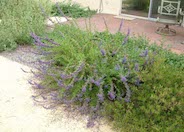
Common name: Woolly Blue Curls
Botanical name: Trichostema lanatum
Woolly Blue Curls is an evergreen shrub that reaches 3'-5' high. It has an open branching habit and has long stalks of brilliant purple woolly flowers in the spring and summer. This California native, is drought tolerant, and attracts hummingbirds. It puts on a dramatic display of purple stealing the show when in bloom. This is a highly prized compact, medium sized shrub that produces breath-taking deep purple to blue flowers. This shrub prefers minimal watering after establishment, well drained soil and plenty of sun. It naturally occurs below 2000' ft. Woolly Blue Curls grows fast, reaching about 4 ft in height and the same in width. The leaves are needle like, thick skinned points that are a light to dark green. The spring and summer flowers are loved by bees, hummingbirds, butterflies, and a favorite of Native gardeners. This very hardy, drought tolerant native was extremely important to indigenous Americans, who used almost all parts of the plant for medicinal uses, especially for stomach ailments. Indeed, it became so important that it was used as a currency at times. Tea made from sprigs of Woolly Blue Curls is also extremely tasty, with a soothing, calming effect.
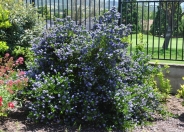
Common name: Dark Star Ceanothus
Botanical name: Ceanothus 'Dark Star'
Dark Star Ceanothus grows to 6' tall and 8' wide, producing small, rounded clusters of dark blue flowers from light burgundy buds that appear in spring. Its habit is compact, with small, dark green, dimpled leaves growing to only 1/2" long. This shrub does best in full sun in coastal areas with well draining soil. It needs very little water once it's established.
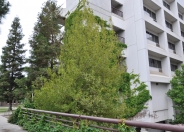
Common name: California Bay
Botanical name: Umbellularia californica
The California Bay is an aromatic evergreen tree or large shrub that slowly reaches 30'-60' high. It tolerates full sun in coastal areas but prefers afternoon shade in warm, inland areas and moderate amount of water. Use foliage for cooking. Yellow flowers appear in spring, followed by purple, inedible fruit.
Additional Common Name: Pepperwood
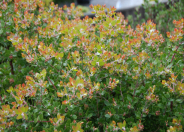
Common name: Sunset Bush Manzanita
Botanical name: Arctostaphylos 'Sunset'
This manzanita is a mounding shrub 4-5' high and 4-6' wide. It has coppery red new growth later turning bright green. It has pinkish-white flowers in winter to early spring. This densely covered shrub prefers full sun and is drought tolerant once it's established. With the diversity of color changes it makes a great foundation shrub.
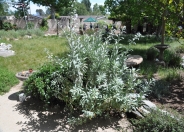
Common name: White Sage
Botanical name: Salvia apiana
This woody shrub has long stiff stems with gray green, wrinkled evergreen leaves when juvenile, changing to smooth and white with time. Fragrant white flowers bloom in the spring, attracting bees. Prune after bloom time to shape shrub. It provides a strong structural form as a garden focal point. It can reach 6' tall and wide; and is considered slow growing. Plant in full sun with well draining soil. Established plants need very little summer water. Leaves have been used for herbal teas and for medicinal purposes.
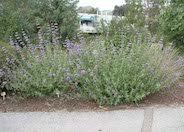
Common name: Purple or Gray Sage
Botanical name: Salvia leucophylla
The Purple Sage is an evergreen shrub that grows 2'-3' tall by 5'-6' wide. It has white tomentose stems and leaves and light lavender purple flowers blooming in late spring. This shrub tolerates heat and drought. The purple sage is a CA native, preferring full sun. Do not overwater. This Sage is great for covering difficult slopes. Foliage is aromatic.
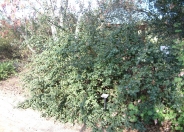
Common name: Coast Silktassel
Botanical name: Garrya elliptica
This shrub will reach about 10' tall and wide. It has small, leathery, dark green leaves with wavy margins and gray woolly undersides. Silvery gray flowers which look like tassels, appear in winter. It tolerates full sun except in hot inland areas; Coast Silktassel appreciates afternoon shade in these areas. It does best in well draining, average soil. It is salt and wind tolerant. It grows in coastal areas also.